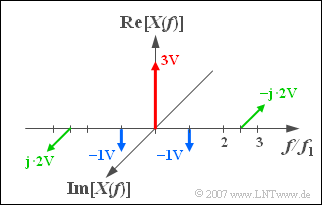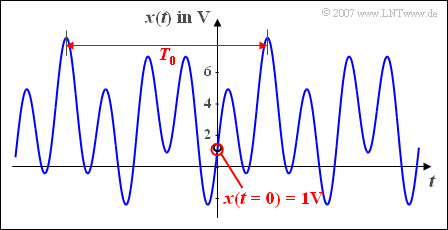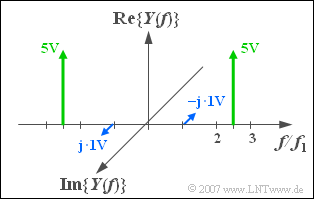Exercise 2.3: Cosine and Sine Components
From LNTwww
Given is the amplitude spectrum $X(f)$ of a signal $x(t)$ according to the graph.
- Let $f_1 = 4\,\text{kHz}$ be the normalisation frequency.
- Thus the actual frequencies of the signal components are $0\,\text{kHz}$, $4\,\text{kHz}$ and $10\,\text{kHz}$.
This signal $x(t)$ is at the input of a linear differentiator whose output can be represented with $\omega_1 = 2\pi f_1$ as follows:
- $$y(t)=\frac{1}{\omega_1}\cdot\frac{ {\rm d} x(t)}{{\rm d} t}.$$
Hint:
- This exercise belongs to the chpater Harmonic Oscillation.
Questions
Solution
(1) Das Zeitsignal hat die folgende Form:
- $$x(t)={\rm 3V}-{\rm 2V}\cdot \cos(\omega_{\rm 1} \cdot t)+{\rm 4V} \cdot \sin(2.5 \cdot \omega_{\rm 1} \cdot t).$$
- Hierbei bezeichnet $\omega_1 = 2\pi f_1$ die Kreisfrequenz des Cosinusanteils.
- Zum Zeitpunkt $t = 0$ hat das Signal den Wert $x(t=0)\hspace{0.15 cm}\underline{=1\,\rm V}$.
(2) Die Grundfrequenz $f_0$ ist der kleinste gemeinsame Teiler
- von $f_1 = 4{\,\rm kHz}$
- und $2.5 · f_1 = 10{\,\rm kHz}$.
Daraus folgt $f_0 = 2{\,\rm kHz}$ ⇒ Periodendauer $T_0 = 1/f_0 \hspace{0.1cm}\underline{= 0.5 {\,\rm ms}}$.
(3) Für das Ausgangssignal $y(t)$ des Differenzierers gilt:
- $$y(t)=\frac{1}{\omega_1}\cdot\frac{ {\rm d}x(t)}{{\rm d}t}=\frac{ {\rm -2V}}{\omega_1}\cdot\omega_1 \cdot (-\sin(\omega_1 t))+\frac{\rm 4V}{\omega_1}\cdot 2.5\omega_1\cdot {\rm cos}(2.5\omega_1t).$$
- Dies führt zum Ergebnis:
- $$y(t)={\rm 2V}\cdot\sin(\omega_1 t)+{\rm 10V}\cdot\cos(2.5\omega_1 t).$$
- Für $t = 0$ ergibt sich der Wert $y(t=0)\hspace{0.15cm}\underline{=10\,\rm V}$.
- Rechts ist das Spektrum $Y(f)$ dargestellt.
(4) Richtig sind die Lösungsvorschläge 1 und 4:
- Die Periodendauer $T_0$ wird durch die Amplitude und die Phase der beiden Anteile nicht verändert.
- Das bedeutet, dass weiterhin $T_0 = 0.5 {\,\rm ms}$ gilt.
- Der Gleichanteil verschwindet aufgrund der Differentiation.
- Der Anteil bei $f_1$ ist sinusförmig. Somit hat $X(f)$ einen (imaginären) Dirac bei $f = f_1$, jedoch mit negativem Vorzeichen.
- Der Cosinusanteil mit der Amplitude ${10\,\rm V}$ hat die beiden Diracfunktionen bei $\pm 2.5 \cdot f_1$ zur Folge, jeweils mit dem Gewicht ${5\,\rm V}$ .


